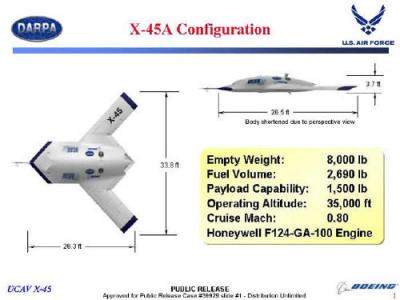Tue, Dec 28, 2004
A Boeing X-45A unmanned aircraft was controlled by a
pilot-operator in Seattle, Wash., after launching from NASA's
Dryden Flight Research Center, Edwards Air Force Base, Calif., on
early December.

“This shows our military can deploy unmanned combat
aircraft from one location and control them from another,”
said Darryl Davis, Boeing Joint Unmanned Combat Air Systems
(J-UCAS) X-45 vice president and program manager. “We're
moving quickly toward delivering a 24/7 strike and reconnaissance
capability to complement America 's manned fighter and bomber
force.”
Using ‘line of sight' command and control, the technology
demonstrator aircraft departed in the morning with a pilot-operator
controlling the jet from its home in Southern California. Once
airborne, the pilot-operator handed control of the unmanned vehicle
over to another Boeing pilot in Seattle. Taking command of the
X-45A using a UHF satellite communications (SATCOM) link, the
Seattle-based pilot-operator demonstrated
‘beyond-line-of-sight' control by commanding multiple
altitude and airspeed changes, which were executed by the vehicle.
Operating from a systems integration lab nearly 900 miles away, the
pilot-operator managed the jet for approximately six minutes before
turning command back to the California-based team, which returned
it to Edwards AFB safely after nearly an hour in the air.

The test mission demonstrated safe and secure vehicle handoff
from mission control to another control center through a SATCOM
link. That capability will be critical when operating the X-45C, a
more robust version of the aircraft being built in St. Louis.
Boeing was recently awarded $767 million in funding from the
Defense Advanced Research Projects Agency (DARPA) to build and
demonstrate three X-45C aircraft, two mission control elements, and
to integrate a common operating system technology for the J-UCAS
program. The first X-45C flight is scheduled to take place in early
2007.

The J-UCAS X-45 program is a DARPA/US Air Force/US Navy/Boeing
effort to demonstrate the technical feasibility, military utility
and operational value of an unmanned air combat system for the Air
Force and the Navy. Operational missions for the services may
include suppression of enemy air defenses; strike; electronic
attack; intelligence, surveillance and reconnaissance; and
persistent global attack. The two X-45A technology demonstrators
are currently verifying the core functionality of the software
necessary for these and related missions.
More News
Airbus Racer Demonstrator Makes Inaugural Flight Airbus Helicopters' ambitious Racer demonstrator has achieved its inaugural flight as part of the Clean Sky 2 initiative, a corners>[...]
A little Bit Quieter, Said Testers, But in the End it's Still a DA40 Diamond Aircraft recently completed a little pilot project with Lufthansa Aviation Training, putting a pair of >[...]
Line Up And Wait (LUAW) Used by ATC to inform a pilot to taxi onto the departure runway to line up and wait. It is not authorization for takeoff. It is used when takeoff clearance >[...]
Contributing To The Accident Was The Pilot’s Use Of Methamphetamine... Analysis: The pilot departed on a local flight to perform low-altitude maneuvers in a nearby desert val>[...]
From 2015 (YouTube Version): Overcoming Obstacles To Achieve Their Dreams… At EAA AirVenture 2015, FedEx arrived with one of their Airbus freight-hauling aircraft and placed>[...]
 Airbus Racer Helicopter Demonstrator First Flight Part of Clean Sky 2 Initiative
Airbus Racer Helicopter Demonstrator First Flight Part of Clean Sky 2 Initiative Diamond's Electric DA40 Finds Fans at Dübendorf
Diamond's Electric DA40 Finds Fans at Dübendorf ANN's Daily Aero-Term (04.23.24): Line Up And Wait (LUAW)
ANN's Daily Aero-Term (04.23.24): Line Up And Wait (LUAW) NTSB Final Report: Extra Flugzeugbau GMBH EA300/L
NTSB Final Report: Extra Flugzeugbau GMBH EA300/L Classic Aero-TV: 'Never Give Up' - Advice From Two of FedEx's Female Captains
Classic Aero-TV: 'Never Give Up' - Advice From Two of FedEx's Female Captains





